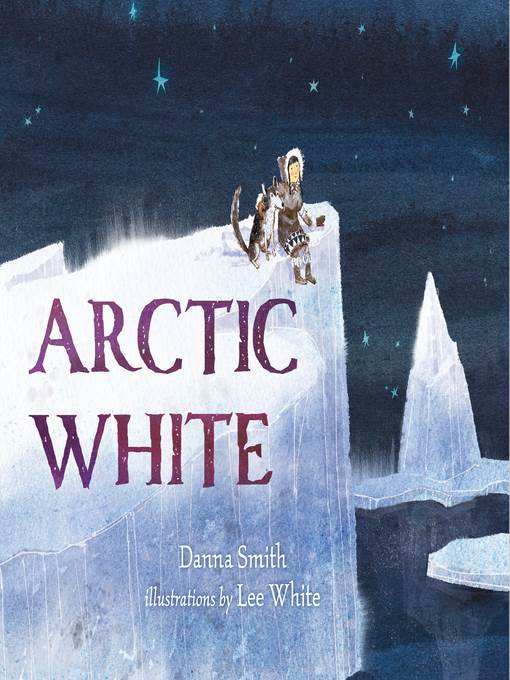
Arctic White
کتاب های مرتبط
- اطلاعات
- نقد و بررسی
- دیدگاه کاربران
نقد و بررسی

November 23, 2015
Smith (Mother Goose’s Pajama Party) follows a child and grandfather of unspecified indigenous background on an ice-fishing excursion in the Arctic, where “everything is a shade of white.” As they travel the tundra, the girl wishes for more color, a wish later granted by the appearance of the Northern Lights. Bundled up in parkas, the girl and her grandfather embark on a nighttime journey over the snow “past the icy sea and sleeping seals. Even footprints are white in the Arctic.” Working in watercolor and ink, White (The Maine Coon’s Haiku) infuses the frozen world with a sense of community, but despite some tender images between girl and grandfather, the overall vagueness and superficiality regarding their heritage strikes an off note. Ages 4–8. Author’s agent: Ronnie Ann Herman, Herman Agency. Illustrator’s agent: Paul Rodeen, Rodeen Literary Management.

October 1, 2015
The Arctic winter is white and gray until something special happens. "When you live in the Arctic in winter," opens the second-person narration, "everything is a shade of white." "You" are a young girl, longing for color. White hues are described]blue-white tundra, the yellow-white of the polar bear, the silver-white of the arctic fox]and outsize, delicate snowflakes drift down. One night, "you hear a hum in the air," and grandfather takes you walking on the tundra to see the northern lights, lush color swaths across the sky. Illustrator White uses watercolor on textured paper to give the snow's surface a gentle nubbiness and depth. Ink delicately outlines human and animal figures. However, setting and culture are unclear. A modern paint box, a bound book, and a flashlight, together with the second-person, present-tense address (placing readers inside the story), imply a contemporary setting, but this girl lives a nonindustrialized life in an iglu, even though most contemporary indigenous Arctic people live in houses. The lack of any specific indigenous nation and some faux Native philosophy]"Grandfather says hope is golden. You can only see it when you look into a snowy owl's eyes"]add to the romanticized Native image. Jan Bourdeau Waboose's SkySisters (2000), an Ojibwe story about walking across tundra to see the northern lights, is a better choice. Despite lovely art, a stereotypically generic and romanticized portrayal of indigenous people. (Picture book. 3-7)
COPYRIGHT(2015) Kirkus Reviews, ALL RIGHTS RESERVED.

December 1, 2015
PreS-Gr 2-A girl trudges across the cold and seemingly colorless Arctic tundra with her grandfather, observing that in winter, everything is a shade of white: the blue-white of the tundra, the yellow-white of the polar bear, and the silver-white of the arctic fox. She wonders where all the color went... "Did the wind blow it away?" Ultimately, after much patience and a mysterious walk with others in their community, her secretive grandfather leads them to the swirling colors of the northern lights, which joyously "dance across the sky." While White's intricate watercolor and ink illustrations are impressive and Smith's poetic imagery thought-provoking (e.g., "Grandfather says hope is golden. You can only see it when you look into a snowy owl's eyes."), readers are never informed where the story takes place, nor the culture of the main characters. A younger audience may also find it confusing comprehending what it means to be a shade of white, particularly the reference to the faint and remote picture of the yellow-white polar bear. The last few pages of the swirling, glowing, swooping northern lights are impressive enough to inspire readers to see this natural phenomenon for themselves (if not through travel, then via a YouTube video). Still, a better read on the topic is Mindy Dwyer's Aurora: A Tale of the Northern Lights (Alaska Northwest, 1997), which includes some background information on this rare and fascinating subject. VERDICT A picturesque book that would be better appreciated with more clarity about its setting and culture.-Etta Anton, Yeshiva of Central Queens, NY
Copyright 2015 School Library Journal, LLC Used with permission.

December 15, 2015
Preschool-G One winter in the Arctic, a girl accompanies her grandfather through the snowy landscape. The dim, gray light leaves their surroundings colorless and drab. Every day, she longs for color, until, one night, she and her grandfather join their neighbors in trudging across the tundra. Atop a snowy mountain, they sit and watch the glowing, pulsing, colorful northern lights. After the lights fade, he carries her home. Inside their igloo, she paints the colors she has seen, flares of hope that brighten the Arctic winter. With sentences such as, When you live in the Arctic in winter, everything is a shade of white, the second-person text draws children into a setting that is, for most, unfamiliar terrain. Created with digitally enhanced watercolors and ink, the illustrations are inviting. In the two double-page aurora borealis scenes, sudden swirls of colors contrast vividly with the whites, grays, and pale hues on the preceding pages. This picture book is a quiet, appealing read-aloud choice for winter storytimes and classroom units on the Arctic.(Reprinted with permission of Booklist, copyright 2015, American Library Association.)

























دیدگاه کاربران